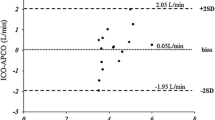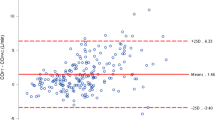Abstract
To compare the accuracy and trending ability of the cardiac index (CI) measured by FloTrac/Vigileo™ (CIFT) or derived by the Fick equation (CIFick) using E-CAiOVX (enables continuous monitoring of oxygen consumption) with that measured by thermodilution (CITD) in patients with off-pump coronary artery bypass surgery. Twenty-two patients undergoing elective off-pump coronary artery bypass surgery were included. CIFT and CIFick were determined simultaneously at six time-points during off-pump coronary artery bypass surgery. At each time-point, phenylephrine (50 µg) was administered to increase systematic vascular resistance, with CI measured before and after administration (CITD used as reference method). Agreement of each method was evaluated by Bland–Altman analysis, while trending ability was evaluated by four-quadrant plot analysis and polar plot analysis. By Bland–Altman analysis, CIFT and CIFick showed percentage errors of 49.5% and 78.6%, respectively, compared with CITD. Subgroup analysis showed a percentage error between COFT and COTD of 28.9% in patients with a CI ≥ 2.4 L/min/m2, and 78.1% in patients with a CI ≥ 2.4 L/min/m2. The concordance rate of four-quadrant plot analysis was 93.3% for CIFT and 66.7% for CIFick in datasets where CITD ≥ 2.4 L/min/m2 before and after phenylephrine administration were included. CIFT and CIFick had wide limits of agreement with CITD, and were below acceptable limits for tracking phenylephrine-induced CI changes. However, subgroup analysis showed improved accuracy and trending ability of CIFT when only points where CITD ≥ 2.4 L/min/m2 were included, while there was no improvement in CIFick accuracy or trending ability.






Similar content being viewed by others
References
Biancofiore G, Critchley LA, Lee A, Yang XX, Bindi LM, Esposito M, Bisa M, Meacci L, Mozzo R, Filipponi F. Evaluation of a new software version of the FloTrac/Vigileo (version 3.02) and a comparison with previous data in cirrhotic patients undergoing liver transplant surgery. Anesth Analg. 2011;113(3):515–22. https://doi.org/10.1213/ANE.0b013e31822401b2.
Suehiro K, Tanaka K, Funao T, Matsuura T, Mori T, Nishikawa K. Systemic vascular resistance has an impact on the reliability of the Vigileo-FloTrac system in measuring cardiac output and tracking cardiac output changes. Br J Anaesth. 2013;111(2):170–7. https://doi.org/10.1093/bja/aet022.
Maeda T, Yoshitani K, Inatomi Y, Ohnishi Y. Inaccuracy of the FloTrac/Vigileo system in patients with low cardiac index. J Cardiothorac Vasc Anesth. 2014;28(6):1521–6. https://doi.org/10.1053/j.jvca.2014.04.013.
Hattori K, Maeda T, Masubuchi T, Yoshikawa A, Ebuchi K, Morishima K, Kamei M, Yoshitani K, Ohnishi Y. Accuracy and Trending ability of the fourth-generation FloTrac/Vigileo system in patients with low cardiac index. J Cardiothorac Vasc Anesth. 2017;31(1):99–104. https://doi.org/10.1053/j.jvca.2016.06.016.
Maeda T, Hattori K, Sumiyoshi M, Kanazawa H, Ohnishi Y. Accuracy and trending ability of the fourth-generation FloTrac/Vigileo system in patients undergoing abdominal aortic aneurysm surgery. J Anesth. 2018;32(3):387–93. https://doi.org/10.1007/s00540-018-2491-y.
Suehiro K, Tanaka K, Mikawa M, Uchihara Y, Matsuyama T, Matsuura T, Funao T, Yamada T, Mori T, Nishikawa K. Improved performance of the fourth-generation flotrac/vigileo system for tracking cardiac output changes. J Cardiothorac Vasc Anesth. 2015;29(3):656–62. https://doi.org/10.1053/j.jvca.2014.07.022.
Pugsley J, Lerner AB. (2010) Cardiac output monitoring: is there a gold standard and how do the newer technologies compare? Semin Cardiothorac Vasc Anesth 14 (4):274–282. https://doi.org/10.1177/1089253210386386.
Thiele RH, Bartels K, Gan TJ. Cardiac output monitoring: a contemporary assessment and review. Crit Care Med. 2015;43(1):177–85. https://doi.org/10.1097/CCM.0000000000000608.
Squara P, Cecconi M, Rhodes A, Singer M, Chiche JD. Tracking changes in cardiac output: methodological considerations for the validation of monitoring devices. Intensive Care Med. 2009;35(10):1801–8. https://doi.org/10.1007/s00134-009-1570-9.
Joosten A, Desebbe O, Suehiro K, Murphy LS, Essiet M, Alexander B, Fischer MO, Barvais L, Van Obbergh L, Maucort-Boulch D, Cannesson M. Accuracy and precision of non-invasive cardiac output monitoring devices in perioperative medicine: a systematic review and meta-analysis dagger. Br J Anaesth. 2017;118(3):298–310. https://doi.org/10.1093/bja/aew461.
Seckeler MD, Hirsch R, Beekman RH 3rd, Goldstein BH. A new predictive equation for oxygen consumption in children and adults with congenital and acquired heart disease. Heart. 2015;101(7):517–24. https://doi.org/10.1136/heartjnl-2014-306378.
Masuda T, Kuramoto M, Tanimoto H, Yamamoto K, Ikeshima S, Kitano Y, Kuroda D, Shimada S, Baba H. Intraoperative baseline oxygen consumption as a prognostic factor in emergency open abdominal surgery. J Crit Care. 2016;32:42–7. https://doi.org/10.1016/j.jcrc.2015.11.014.
Langewouters GJ, Wesseling KH, Goedhard WJ. The pressure dependent dynamic elasticity of 35 thoracic and 16 abdominal human aortas in vitro described by a five component model. J Biomech. 1985;18(8):613–20.
Kanda Y. Investigation of the freely available easy-to-use software ‘EZR’ for medical statistics. Bone Marrow Transplant. 2013;48(3):452–8. https://doi.org/10.1038/bmt.2012.244.
Bland JM, Altman DG. Statistical methods for assessing agreement between two methods of clinical measurement. Lancet. 1986;1(8476):307–10.
Critchley LA, Critchley JA. A meta-analysis of studies using bias and precision statistics to compare cardiac output measurement techniques. J Clin Monit Comput. 1999;15(2):85–91.
Gillies M, Bellomo R, Doolan L, Buxton B. Bench-to-bedside review: Inotropic drug therapy after adult cardiac surgery -- a systematic literature review. Critical Care. 2005;9(3):266–79. https://doi.org/10.1186/cc3024.
Abualsaud AO, Lowe BS, Guo K, Marelli AJ, Kaouache M, Guo L, Jutras L, Martucci G, Therrien J. Cardiac output as a predictor in congenital heart disease: are we stating the obvious? Int J Cardiol. 2016;210:143–8. https://doi.org/10.1016/j.ijcard.2016.02.071.
Critchley LA, Yang XX, Lee A. Assessment of trending ability of cardiac output monitors by polar plot methodology. J Cardiothorac Vasc Anesth. 2011;25(3):536–46. https://doi.org/10.1053/j.jvca.2011.01.003.
Critchley LA, Lee A, Ho AM. A critical review of the ability of continuous cardiac output monitors to measure trends in cardiac output. Anesth Analg. 2010;111(5):1180–92. https://doi.org/10.1213/ANE.0b013e3181f08a5b.
Ji F, Li J, Fleming N, Rose D, Liu H. Reliability of a new 4th generation FloTrac algorithm to track cardiac output changes in patients receiving phenylephrine. J Clin Monit Comput. 2015;29(4):467–73. https://doi.org/10.1007/s10877-014-9624-0.
Lin SY, Chou AH, Tsai YF, Chang SW, Yang MW, Ting PC, Chen CY. Evaluation of the use of the fourth version FloTrac system in cardiac output measurement before and after cardiopulmonary bypass. J Clin Monit Comput. 2017. https://doi.org/10.1007/s10877-017-0071-6.
Smithies MN, Royston B, Makita K, Konieczko K, Nunn JF. Comparison of oxygen consumption measurements: indirect calorimetry versus the reversed Fick method. Crit Care Med. 1991;19(11):1401–6.
Peyton PJ, Robinson GJ. Measured pulmonary oxygen consumption: difference between systemic oxygen uptake measured by the reverse Fick method and indirect calorimetry in cardiac surgery. Anaesthesia. 2005;60(2):146–50. https://doi.org/10.1111/j.1365-2044.2004.04044.x.
Shepard JW Jr, Minh VD, Dolan GF. Gas exchange in nonperfused dog lungs. J Appl Physiol. 1981;51(5):1261–7. https://doi.org/10.1152/jappl.1981.51.5.1261.
Light RB. Intrapulmonary oxygen consumption in experimental pneumococcal pneumonia. J Appl Physiol. 1988;(1985) 64(6):2490–5. https://doi.org/10.1152/jappl.1988.64.6.2490.
Acknowledgements
We thank GE Healthcare for rental of the E-CAiOVX (GE Healthcare, WI, US), and Jane Charbonneau, DVM, from Edanz Group (http://www.edanzediting.com/ac), for editing a draft of this manuscript. We also thank the resident doctors who cared for the patients in this study.
Funding
This study was supported in part by JSPS KAKENHI (Grant Number JP17K11100).
Author information
Authors and Affiliations
Corresponding author
Ethics declarations
Conflict of interest
None.
Ethical approval
All procedures performed in studies involving human participants were in accordance with the ethical standards of the institutional and/or national research committee and with the 1964 Helsinki declaration and its later amendments or comparable ethical standards.
Informed consent
Informed consent was obtained from all individual participants included in the study.
Electronic supplementary material
Below is the link to the electronic supplementary material.
10877_2018_217_MOESM1_ESM.pdf
Supplementary Figure S1. Cubic spline function curves of the relationship between CITD and CI discrepancy (i.e., (CIFT − CITD)/CITD). Shaded areas represent 95% confidence intervals. (PDF 192 KB)
10877_2018_217_MOESM2_ESM.pdf
Supplementary Figure S2. Cubic spline function curves of the relationship between CITD and CI discrepancy (i.e., (CIFick − CITD)/CITD). Shaded areas represent 95% confidence intervals. (PDF 191 KB)
10877_2018_217_MOESM3_ESM.pdf
Supplementary Figure S3. Cubic spline function curves of the relationship between SVRI and CI discrepancy (i.e., (CIFT − CITD)/CITD). Shaded areas represent 95% confidence intervals. (PDF 207 KB)
Rights and permissions
About this article
Cite this article
Maeda, T., Hamaguchi, E., Kubo, N. et al. The accuracy and trending ability of cardiac index measured by the fourth-generation FloTrac/Vigileo system™ and the Fick method in cardiac surgery patients. J Clin Monit Comput 33, 767–776 (2019). https://doi.org/10.1007/s10877-018-0217-1
Received:
Accepted:
Published:
Issue Date:
DOI: https://doi.org/10.1007/s10877-018-0217-1




